Chapter 27: Traveling down the river to Borja
AS TOLD BY GRO AGERSTEN
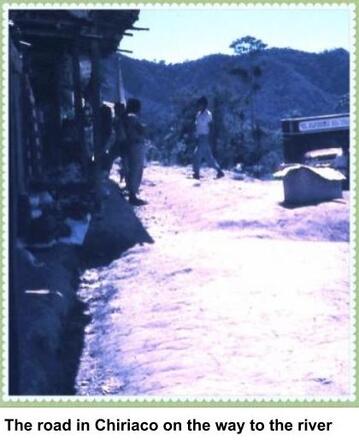
It was market day the day after we arrived in Chiriaco with the moving truck. The rain had stopped, and merchants had spread their wares on plastic tarps along the narrow dirt roads in the center of the village. There were fabrics, threads, other sewing tools, soaps, pots and pans, tin plates and cups, and many other things that could be tempting for both mestizo and native buyers. People came to shop from villages further down the river and farms in the region. Many thousand natives from the Awajun tribe lived in this area around the Chiriaco and Marañon rivers. The region is large, but people who live off fishing, hunting, and slash-and-burn agriculture need a lot of space. Many poor mestizos were moving into the area from the mountains desperate for land and work. However, this was making it challenging for the native tribes to continue their traditional lifestyles - quite a dilemma.
“Mom, look at that man! He is wearing a skirt and has long hair. And look at her! She’s wearing a strange dress.” Maino’s comments interrupted my thoughts as we rode in the truck between merchants and shoppers on the way to the river. She had seen some natives from the Awajun tribe in their traditional dress. Both men and women wore straight and long hair with bangs and a notch cut in by the ears. The men wore a black-brown piece of fabric tied around their waist that reached down to their knees. The women wore a wider piece tied up over one shoulder that looked like a simple dress. In times past they would have woven the cloth themselves from threads spun from wild cotton. Many still dressed in the traditional way, but we could see that some chose to follow the mestizo fashion. Particularly men had gotten comfortable with pants and shirts, but you could still tell they were Awajun by their appearance and hairstyle.
“Mom, look at that man! He is wearing a skirt and has long hair. And look at her! She’s wearing a strange dress.” Maino’s comments interrupted my thoughts as we rode in the truck between merchants and shoppers on the way to the river. She had seen some natives from the Awajun tribe in their traditional dress. Both men and women wore straight and long hair with bangs and a notch cut in by the ears. The men wore a black-brown piece of fabric tied around their waist that reached down to their knees. The women wore a wider piece tied up over one shoulder that looked like a simple dress. In times past they would have woven the cloth themselves from threads spun from wild cotton. Many still dressed in the traditional way, but we could see that some chose to follow the mestizo fashion. Particularly men had gotten comfortable with pants and shirts, but you could still tell they were Awajun by their appearance and hairstyle.
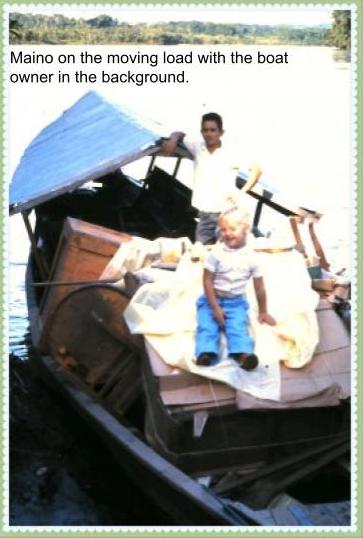
Down by the river.
The riverside was full of life. There were several rafts and canoes tied to the edge of the river. They were loaded down with bananas, manioc, and papayas and we could see native women carrying large baskets of manioc on their backs. The baskets hung by a “rope” of bark that went around their forehead. There were also several trucks standing around ready to bring some of these wares to Bagua and other places in the area.
A little further down from the canoes and rafts, we spotted the boat that was going to ferry us and our moving load down the Marañon river. It was a 40-foot wooden boat with a tin roof and a 40hp outboard engine. The owner smiled broadly when he saw us. John knew him from an earlier trip down the river. We were happy to see that he was waiting for us as agreed. As soon as we were close enough to hear him, the owner gave us his news: “I don’t think we will get further than Nieva today. The water level is too high after all the recent rain to pass the Manseriche rapids.” To soften the blow, he added quickly: “This is not the normal season for high water levels, so I’m sure we will be able to continue down the river after a couple of days.”
The boat owner’s report was unexpected because we had planned our trip during this time of year precisely because we knew that it was the season for lower water in the river which made it the best time to pass through the rapids. But of course, we understood that all we could do was wait and hope for the best. The military base located at the upper side of the rapids would not allow anyone to pass if the water was above a certain level.
It was actually an advantage that the water levels were high as far as loading our things onto the boat. It didn’t take long to get everything on board with the help of both the boat owner and the truck driver. The tarp covering our things in the bed of the truck had not been entirely effective. Several things were damp, and one of the mattresses was soaked, so it was much heavier than usual! We were quite worried by how low the boat sat in the water once everything was loaded. “It’s no problem, this boat could handle more than this!” The owner just laughed at our worried expressions. We just had to trust him and hope he was right.
Quite a crowd had gathered to watch this unusual cargo being loaded and they wondered about these “gringos” (whites) that were traveling down the river. They were especially curious about Maino’s and Lewi’s blond hair. Some reached out to touch them, and some even pulled on their hair to see if it was really fastened to their heads. We hurried up into the boat and made our way past the load to a wooden bench on the side. The owner went back to the motor to steer. He couldn’t see much past the load, but he had a boy with him that stayed up front and shouted directions so we could avoid logs, rocks, or shallow places in the river.
The riverside was full of life. There were several rafts and canoes tied to the edge of the river. They were loaded down with bananas, manioc, and papayas and we could see native women carrying large baskets of manioc on their backs. The baskets hung by a “rope” of bark that went around their forehead. There were also several trucks standing around ready to bring some of these wares to Bagua and other places in the area.
A little further down from the canoes and rafts, we spotted the boat that was going to ferry us and our moving load down the Marañon river. It was a 40-foot wooden boat with a tin roof and a 40hp outboard engine. The owner smiled broadly when he saw us. John knew him from an earlier trip down the river. We were happy to see that he was waiting for us as agreed. As soon as we were close enough to hear him, the owner gave us his news: “I don’t think we will get further than Nieva today. The water level is too high after all the recent rain to pass the Manseriche rapids.” To soften the blow, he added quickly: “This is not the normal season for high water levels, so I’m sure we will be able to continue down the river after a couple of days.”
The boat owner’s report was unexpected because we had planned our trip during this time of year precisely because we knew that it was the season for lower water in the river which made it the best time to pass through the rapids. But of course, we understood that all we could do was wait and hope for the best. The military base located at the upper side of the rapids would not allow anyone to pass if the water was above a certain level.
It was actually an advantage that the water levels were high as far as loading our things onto the boat. It didn’t take long to get everything on board with the help of both the boat owner and the truck driver. The tarp covering our things in the bed of the truck had not been entirely effective. Several things were damp, and one of the mattresses was soaked, so it was much heavier than usual! We were quite worried by how low the boat sat in the water once everything was loaded. “It’s no problem, this boat could handle more than this!” The owner just laughed at our worried expressions. We just had to trust him and hope he was right.
Quite a crowd had gathered to watch this unusual cargo being loaded and they wondered about these “gringos” (whites) that were traveling down the river. They were especially curious about Maino’s and Lewi’s blond hair. Some reached out to touch them, and some even pulled on their hair to see if it was really fastened to their heads. We hurried up into the boat and made our way past the load to a wooden bench on the side. The owner went back to the motor to steer. He couldn’t see much past the load, but he had a boy with him that stayed up front and shouted directions so we could avoid logs, rocks, or shallow places in the river.
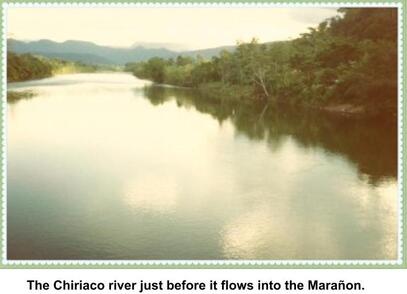
Traveling downriver.
I was feeling pretty nervous as the engine started and we headed down the narrow, twisting river at a good speed. It started raining again, and the currents were faster than usual because of the high water level. John encouraged me by saying that the motorist had traveled this stretch hundreds of times and knew the river very well. For me, river travel was a totally new experience, but John had now been here a few times. Chiriaco is a narrow and pretty shallow river. The jungle stood like a wall on each side, and in places, branches from really big trees met across the river and made a roof above us. But we didn’t have to go far before the clear water of the Chiriaco flowed into the muddy waters of the larger river Marañon.
We passed several Awajun villages situated on higher spots along the riverbanks. In several places, we had to pass through small rapids. The waters were whirling and foaming around us, but we got through safely. After about eight hours' travel, we arrived at the village Santa Maria de Nieva which is situated beautifully on a hill at the mouth of another tributary by the same name. We went up the tributary a little way and docked at the riverside where the path came down from the village. Happily, the rain had stopped some time ago so we stayed dry getting out. The owner assured us our moving load would be safe on the boat until the water levels dropped and we could move on. The boy that worked for him would sleep in the boat and watch over it. We didn’t actually have a choice anyway. We took our bags and suitcases with us and sent up a quiet prayer for protection over our things and the boat.
We were clearly in Awajun territory as we could see many men and women in their traditional dress and hairstyle. There were some mestizos as well dressed in regular western clothes. We stood out as we headed slowly up to the village’s only hotel with our luggage. The hotel was a similar style to the one in Chiriaco, but at least we did not have to climb any ladders to our room. Here they had dirt floors and bamboo walls like most other houses in Nieva. It did distinguish itself by having a tin roof instead of the usual palm leaves. Further up the hill, we could see a Catholic church and a house where a Spanish priest lived. There was also a small clinic, a school, and a boardinghouse for native children. All of those were staffed by nuns from Spain.
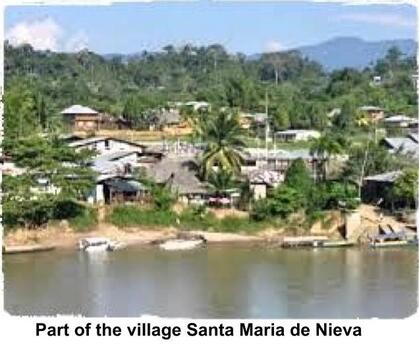
Visiting the Catholic priest and the nuns
The next morning we discovered that Lewi had an ear infection. We took him up to the clinic run by the nuns and waited under the shade of a palm roof along with several other patients. Many were Awajun women with small children. We were kindly received, and Lewi got the medication he needed. On the way back to the hotel we met the Catholic priest. He was excited to talk to other Europeans and invited us to have coffee with him. We accepted the invitation and were ushered into a simple home where we were treated to coffee and cookies. The children were given soft drinks which they really enjoyed. The conversation started with us telling who we were and why we were traveling in the jungle as the priest was quite curious about that. Then he started telling us hair-raising stories about the first Catholic missionaries who had traveled in the jungle around three hundred years ago. His stories about their primitive travels along jungle paths and balsa rafts along the river and down the rapids made our own expedition sound almost like a luxury trip. Several of these early priests were killed by the natives who feared strangers. It was a very interesting visit, and it seemed he enjoyed the break from the everyday routines as well. He wished us well as we said goodbye and walked down to our simple accommodations.
The next morning we discovered that Lewi had an ear infection. We took him up to the clinic run by the nuns and waited under the shade of a palm roof along with several other patients. Many were Awajun women with small children. We were kindly received, and Lewi got the medication he needed. On the way back to the hotel we met the Catholic priest. He was excited to talk to other Europeans and invited us to have coffee with him. We accepted the invitation and were ushered into a simple home where we were treated to coffee and cookies. The children were given soft drinks which they really enjoyed. The conversation started with us telling who we were and why we were traveling in the jungle as the priest was quite curious about that. Then he started telling us hair-raising stories about the first Catholic missionaries who had traveled in the jungle around three hundred years ago. His stories about their primitive travels along jungle paths and balsa rafts along the river and down the rapids made our own expedition sound almost like a luxury trip. Several of these early priests were killed by the natives who feared strangers. It was a very interesting visit, and it seemed he enjoyed the break from the everyday routines as well. He wished us well as we said goodbye and walked down to our simple accommodations.
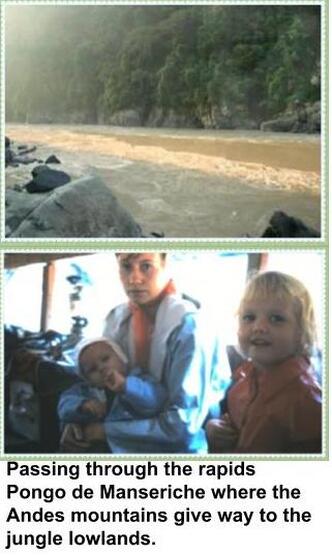
“Mañana’ - tomorrow - was a frequently used word in Latin America along with “paciencia” - patience. We heard these words quite a bit in Nieva when we walked down to the river several times a day to check the water levels. It hadn’t rained anymore since we came so we were hoping it would get lower quickly. On the second day, we could really see it was going down even if it was slowly. We ended up having to spend three nights in Nieva before the river had gone down enough that we could continue on our way. A few hours downriver we came to Pinglo, a military base where everyone had to stop and get permission to go through the rapids of Pongo de Manseriche. Our identity documents were inspected thoroughly and after many questions, we were permitted to continue our journey.
The Pongo de Manseriche
As John described in an earlier chapter, the rapids here at Manseriche were pretty scary. The river presses itself down through a narrow passage in the easternmost part of the Andes mountain range. The water levels were still relatively high which made the waters extra rough, so I must admit I was pretty scared the whole way down. Maino and Lewi sat quite still and looked wide-eyed out on the foaming swirls, waves, rocks, and logs all around the boat. But we made it through safely thanks to the motorist’s skills and knowledge of the river and the rapids. We were all relieved when we reached the village of Borja just downriver from the rapids. It felt great to have solid ground under our feet again. Someone helped us tie up the boat, and then helped unload our things and store them in a house close to the river. The house also had a room where we could sleep until we were ready to travel on our own boat. Seventeen years would pass before we crossed these rapids again. From the village where we settled, we found that it was simpler to travel downriver to the cities of Yurimaguas or Iquitos. Eventually, we were even able to travel by pontoon planes either from San Lorenzo or with the Wycliffe missionaries.
The Pongo de Manseriche
As John described in an earlier chapter, the rapids here at Manseriche were pretty scary. The river presses itself down through a narrow passage in the easternmost part of the Andes mountain range. The water levels were still relatively high which made the waters extra rough, so I must admit I was pretty scared the whole way down. Maino and Lewi sat quite still and looked wide-eyed out on the foaming swirls, waves, rocks, and logs all around the boat. But we made it through safely thanks to the motorist’s skills and knowledge of the river and the rapids. We were all relieved when we reached the village of Borja just downriver from the rapids. It felt great to have solid ground under our feet again. Someone helped us tie up the boat, and then helped unload our things and store them in a house close to the river. The house also had a room where we could sleep until we were ready to travel on our own boat. Seventeen years would pass before we crossed these rapids again. From the village where we settled, we found that it was simpler to travel downriver to the cities of Yurimaguas or Iquitos. Eventually, we were even able to travel by pontoon planes either from San Lorenzo or with the Wycliffe missionaries.
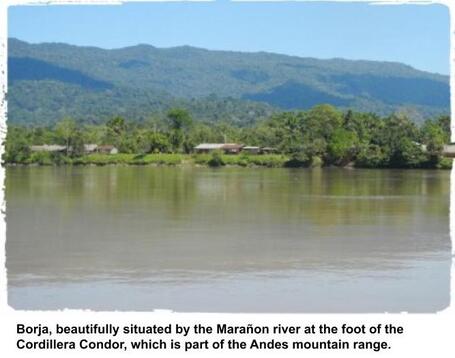
Borja
Unfortunately, our boat, “El Sembrador”, was a sorry sight when we arrived in Borja. Half of it was laying on dry land and the outboard motor that was stored inside the boat was partially submerged in the murky river water. John would have to do a lot of work with it before it would be ready to take us further down the river. He wrote about it later in a letter to the Lindgrens: ” The situation that awaited us when we arrived in Borja was not good. I had paid a man to look after the boat, but he had been out of it for a few days, so his kids had looked after it according to him. Well, the boat was grounded when the water levers sank and tipped over to one side. There were clear signs that there had been water over the floor level in the boat and the motor partially submerged. Fortunately, the water had not reached the electronics in the motor, and I got it running again. There had also been someone in the boat who stole a few things. It was our second robbery in just four days! Still, the thing we miss the most is the transistor radio that was stolen in Bagua. We had wanted to keep up with what was happening in the rest of the world with that radio, but that was not to be.”
We were thankful for the beautiful, sunny weather we had while in Borja. We laid all our damp clothes and the soaked mattresses to dry on the tin roof of the boat. Some of the boxes of canned goods and sacks of rice and flour were also damp, so we set them on the ground outside to get their share of the sunny weather. It all took a few days to dry. Meanwhile, we cleaned up the boat inside where the river water had left mud and debris and John cleaned and repaired the outboard motor. On October 26th we were finally ready to leave Borja. By then we had also hired a young man to go with us on the journey, and he turned out to be of great help to us in many ways in the exciting weeks that lay ahead.
Unfortunately, our boat, “El Sembrador”, was a sorry sight when we arrived in Borja. Half of it was laying on dry land and the outboard motor that was stored inside the boat was partially submerged in the murky river water. John would have to do a lot of work with it before it would be ready to take us further down the river. He wrote about it later in a letter to the Lindgrens: ” The situation that awaited us when we arrived in Borja was not good. I had paid a man to look after the boat, but he had been out of it for a few days, so his kids had looked after it according to him. Well, the boat was grounded when the water levers sank and tipped over to one side. There were clear signs that there had been water over the floor level in the boat and the motor partially submerged. Fortunately, the water had not reached the electronics in the motor, and I got it running again. There had also been someone in the boat who stole a few things. It was our second robbery in just four days! Still, the thing we miss the most is the transistor radio that was stolen in Bagua. We had wanted to keep up with what was happening in the rest of the world with that radio, but that was not to be.”
We were thankful for the beautiful, sunny weather we had while in Borja. We laid all our damp clothes and the soaked mattresses to dry on the tin roof of the boat. Some of the boxes of canned goods and sacks of rice and flour were also damp, so we set them on the ground outside to get their share of the sunny weather. It all took a few days to dry. Meanwhile, we cleaned up the boat inside where the river water had left mud and debris and John cleaned and repaired the outboard motor. On October 26th we were finally ready to leave Borja. By then we had also hired a young man to go with us on the journey, and he turned out to be of great help to us in many ways in the exciting weeks that lay ahead.